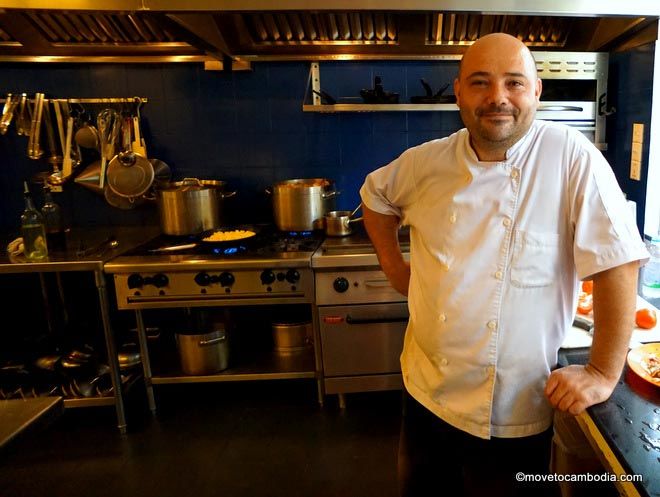Since it opened three years ago, Cuisine Wat Damnak in Siem Reap has become a critically acclaimed culinary institution, attracting patrons from all over the world. Many consider it the mecca for modern Cambodian cuisine, and they’ve just been honored by being named one of the 50 best restaurants in Asia.
This is the last of five posts from Steven, who spent time working in the Cuisine Wat Damnak kitchen, covering a five-course menu and describing some of the techniques and flavor combinations that Chef Joannès Rivière uses to such brilliant effect. Chef Rivière’s recipes have inspired a legion of chefs in Cambodia, both local and foreign. He has graciously supplied some simple recipes and cooking tips to inspire your kitchen, too.

Coconut panna cotta and sorbet with turmeric-braised pineapple at Cuisine Wat Damnak.
We’ve reached the last course of our five-course menu from Cuisine Wat Damnak, and that means it’s time for dessert! For this recipe Chef Rivière applies his pastry training to some local ingredients to create a light, fruity dessert that will fit nicely at the end of any meal. The panna cotta and the sorbet provide an indulgent base and the pineapple and turmeric mix, braised in white wine, adds a tartness that beautifully balances the overall flavor. The slight hint of turmeric gives added dimension to this simple and classic dessert.
Coconut panna cotta and sorbet with turmeric-braised pineapple
For the panna cotta:
250-ml can coconut milk
125 g sugar
1 cup toasted coconut
3 sheets leaf gelatin
500 ml heavy cream
4 pineapples
1 thumb of turmeric, peeled and grated
1 tablespoon honey
Half a bottle white wine (preferably Sauvignon Blanc)
For the sorbet (see Chef’s Notes):
3 kg fresh coconut cream/water
200 g sugar
50 g glucose powder (see Chef’s Notes)
1 sheet leaf gelatin
200 g water
- Prepare the panna cotta: Put the gelatin leaves into cold water to soften. Meanwhile, boil the can of coconut milk with the sugar and toasted coconut. Leave to infuse for 5 minutes, then strain out the solids. Squeeze the gelatin dry, then whisk it into the hot strained liquid.
- Allow this coconut base to cool until it reaches room temperature.
- Whip the cream until soft-to-firm peaks form and fold gently into the coconut base. Pour into individual glasses or cups and refrigerate.
- Prepare the pineapples: Skin and core the pineapples and chop into small chunks. Place in a pan with the grated turmeric, honey, and white wine. Boil for 15 minutes, allowing the liquid to reduce by about half. Set aside to cool, then refrigerate.
- Place the coconut water in a plastic container and refrigerate. The cream will rise to the top. Skim off the cream with a ladle and keep chilled in a separate container. There should be about a liter of coconut cream.
- Prepare an ice bath by putting ice and water in a bowl. Take a smaller metal bowl that will fit inside the ice bath and place it in the freezer.
- Put the sugar, glucose, leaf of gelatin, and 200 g water in a pan. Bring to a boil and mix in the coconut cream. Bring the mixture up to a maximum of 65 Celsius (use a candy thermometer to measure).
- Remove the metal bowl from the freezer. Pour the coconut cream mixture into it. Place the bowl in the ice bath and whisk the coconut mixture until cool. Blend the mixture with a hand blender, then refrigerate until completely chilled.
- Once the mixture is chilled, it is ready to go into your ice-cream maker. (See Chef’s Notes.)
- To assemble, spoon some of the pineapple mixture on top of the individual servings of panna cotta. Top with a scoop of the sorbet and serve.

Chef Joannès Rivière chillin’ in the Cuisine Wat Damnak kitchen.
Chef’s Notes
This dessert can be prepared well in advance; the panna cotta and the pineapple mixture will keep in the fridge for several days and the sorbet will keep in the freezer for even longer.
It’s important to use glucose in making the sorbet, as it will stop the mixture from crystallizing and freezing too hard.
If you don’t have an ice-cream maker, but you do have a sturdy food processor, you can make the sorbet as follows, starting the day before you plan to serve it: Put the coconut cream mixture from step 7 in the freezer and allow it to freeze halfway, then mix it up with a fork. Leave it to freeze overnight. The next day, chill the bowl of your food processor in the freezer. Chop up the frozen sorbet mixture, then place it into the cold food-processor bowl and blend until smooth. However, your processor should be good and strong in order to accomplish this. If you do not have access to either an ice-cream maker or a sufficiently powerful food processor, buy coconut sorbet or ice cream instead.

Cooking up a storm at Siem Reap’s Psar Cha.
A note about Cambodian cooking
Rivière points out that Cambodian cooking, and indeed South East Asian cooking generally, is by no means an exact science. The recipes he has provided feature all of the ingredients you will need and the techniques required to execute the dishes, but the exact amounts used will depend on your taste.
Use the ingredients sensibly and taste as you go. Masses of sugar will obviously make a dish too sweet, while not enough fish sauce may leave the dish bland and underseasoned.
The more you cook a cuisine the more accustomed you become to the basics involved. Certain ingredients come up again and again and you will learn what they do and how to use them properly. We have tried to be as clear as possible in the presentation of these recipes, but they all require you to just roll up your sleeves and give them a go.
If you’re in Siem Reap, be sure to make a reservation at Chef Rivière’s restaurant, Cuisine Wat Damnak. The restaurant will be closed from March 29 to May 4, so make your reservation now!
Leave a Reply